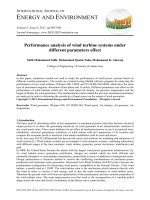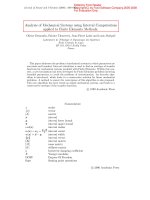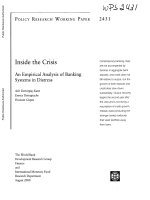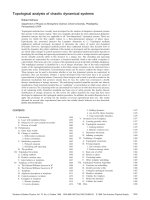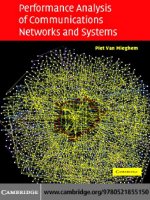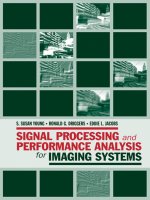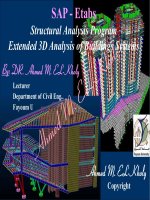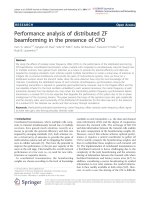Performance Analysis of Network-MIMO Systems
Bạn đang xem bản rút gọn của tài liệu. Xem và tải ngay bản đầy đủ của tài liệu tại đây (1.07 MB, 47 trang )
Performance Analysis of Network-MIMO
Systems
Tạ Đức Tuyển
Trường Đại học Công nghệ
Luận văn ThS ngành: Kỹ thuật Điện tử - Viễn thông; Mã số: 60 52 70
Người hướng dẫn: TS. Trịnh Anh Vũ
Năm bảo vệ: 2010
Abstract: Network MIMO is a means of coordinating and processing the
information gathered from multiple- input multiple- output (MIMO)
communication systems to increase spectral efficiency, robustness, and data
rates. These properties make it a topic of great interest in the near future as
the number of wireless users continues to grow and their individual
demands on bandwidth climb. Systems employing network MIMO
capitalize on the fact that inter-cell interference, a major problem for dense
wireless systems, is a superposition of signals. With careful coordination
between receivers (and transmitters), these super-positions can be
decoupled and the information they contain can be utilized. The goal of this
thesis is to investigate the ability of network MIMO techniques to increase
data rates in multi-user indoor wireless networks of various sizes with
various channel schemes. The simulation results also show that Network
MIMO systems can be increase data rates and good through put than nonnetworked MIMO systems.
Keywords: Kỹ thuật điện tử; Mạng Mimo; Xử lý thông tin; Mạng truyền
thông
Content
CHAPTER 1: INTRODUCTION
Modern wireless networks tend to be interference limited, mainly caused by
their own base stations and mobile terminals. Suppressing interference would thus
result in significant improvements in data rates, capacity, and coverage. Our
studies determined the feasibility of achieving significant performance Network
MIMO (Multiple-Input/Multiple-Output) gains. This led to a proposed solution to
suppress inter-cell interference via phase- coherent coordination and joint spatial
filtering between the base stations.
1.1 Wireless Communication
Wireless communication services are basic features of global civilization, soon
available everywhere and adopted by everyone. The development has been
especially rapid in the last few decades, in which time wireless communications
has taken a leap from being a niche technology towards achieving a status as an
independent growth industry and diverse research area [1].
The history of wireless communication technologies can be traced back
over 140 years, to Maxwell’s theories on electromagnetic waves and Hertz’ later
demonstration of their existence [2]. Marconi’s 1896 invention of wireless
telegraphy
supplied
the
first
useful
application,
enabling
transatlantic
communication services. Then followed radiotelephony, and commercial car
phone services were spreading slowly from the late 1920s [3].
First generation (1G) personal mobile phone systems came in the early
1980s, with user terminals that were expensive and of questionable portability.
However, the introduction of a cellular structure, for base station location and
frequency reuse, helped control the interference and made the networks more
easily scalable, and the wireless revolution was ignited. The analog 1G networks
were followed by the digital second generation (2G) systems, among which the
GSM, first introduced for regular service in Finland in 1991, is one successful
example.
Third generation (3G) standards were released from 2000, aiming for
unified global roaming, more users and higher data rates. However, the actual
deployment of networks was long delayed by enormous spectrum licensing fees
and a lack of industry incentive. The fourth generation (4G) of wireless networks,
also known as Beyond 3G, notably include implementations of the WiMAX and
the Long-Term Evolution (LTE) standards [4].
For years, there is an on-going shift in end-user mobile communications
service. The future of wireless communication is multimedia, which includes
image, video, and local area network applications; with the data transmission rate
more than 1000 times faster than that of the present systems. However, the
physical limits imposed by the mobile radio channel cause performance
degradation and make it very difficult to achieve high bit rate at low error rate
over the time dispersive wireless channels. Another key limitation is co-channel
interference (CCI) which can also significantly decrease the capacity of wireless
and personal communications systems.
1.2 MIMO Techniques
As presented in Section 1, future wireless communication networks will need to
support extremely high data rates in order to meet the rapidly growing demand for
broadband applications. Existing wireless communication technologies cannot
efficiently support broadband data rates, due to their sensitivity to fading. Multiple
antennas have recently emerged as a key technology in wireless communication
systems for increasing both data rates and system performance.
The benefits of exploiting Multiple-Input-Multiple-Output (MIMO) may be
categorized by the following [6]:
Array gain
Array gain refers to the average increase in the SNR at the receiver that arises
from the coherent combining effect of multiple antennas at the receiver or
transmitter or both. The average increase in signal power at the receiver is
proportional to the number of receive antennas.
Diversity gain
Signal power in a wireless channel fluctuates. When the signal power drops
significantly, the channel is said to be in a fade. Diversity is used in wireless
channels to combat fading. Utilization of diversity in MIMO channels requires
antenna diversity at both receive and transmit side. The diversity order is equal to
the product of the number of transmit and receive antennas, if the channel between
each transmit-receive antenna pair fades independently.
Spatial multiplexing (SM)
SM offers a linear (in the number of transmit-receive antenna pairs or min (Mt, Mr)
increase in the transmission rate for the same bandwidth and with no additional
power consumption.
Interference reduction
Co-channel interference arises due to frequency reuse in wireless channels. When
multiple antennas are used, the difference between the spatial signatures of the
desired signal and co-channel signals can be exploited to reduce the interference.
This operation is done at the receiver side.
Figure 1 MIMO communication from SISO to IA-MIMO (Source:
www.wikipedia.org)
In addition, we will increase system performance or reduce cost by apply some
enhancement techniques to MIMO communication systems. These can be
categorized into two groups: evolutionary and revolutionary approaches.
Evolutionary approaches:
1. Use an existing techniques with enhanced PHY capabilities, perhaps
a 16×16 array configuration.
2. Use new MIMO algorithms such as pre-coding or multi-user
scheduling at the transmitter.
Revolutionary approaches: developing the fundamentally of new MIMO
concepts.
Based on the literature, we summarize a number of advanced MIMO techniques
that leverage multiple users as seen in Fig 1:
Cross-layer MIMO: Scheduling, etc.
Advanced decoding MIMO: Multi-user detection such as MLD.
Beamforming and SDMA: widely known multi-user MIMO (MU-MIMO)
scheme.
Infrared/Non-infrared network optimization.
Network MIMO (Net-MIMO).
Cognitive MIMO based on intelligent techniques.
Cooperative/competitive MIMO.
Cooperation: DPC, Wyner-Ziv, etc.
Competitive: Game theory, autonomous packets, implicit MAC fairness.
etc
1.3 Network-MIMO systems
Network MIMO is a MIMO communication scheme, which falls within the family
of techniques that use cooperation in a MIMO systems to increase system
performance. More specifically, network MIMO is a family of techniques whereby
each end user in a wireless access network is served not just by multiple antennas
but also by multiple access points [8]. This allows users similar performance
increases to those seen in other MIMO processing methods but achieves it by
taking advantage of the already existing infrastructure in any multi-point access
network.
For example, an indoor wireless system for a small business would have
several access points (AP). These access points would all be connected through a
wired grid to a central router and then to the internet via an ISP. Taking advantage
of the fact, these access points are all connected, network MIMO could be used to
coordinate the transmission and reception of data without needing to add
additional antennas to local access points.
1.4 Thesis’s Structure
In general terms, this thesis focuses on performance analysis of network MIMO
systems. Because Network-MIMO is an enhancement model of the original
MIMO systems, we first analysis the theoretical of MIMO techniques in Chapter
2. That is the basic knowledge to work with Network-MIMO in the next chapters.
In Chapter 3, we consider a Network-MIMO systems where two or more
AP served each end-user to achieve high system performance while also reduces
the system interference.
Chapter 4 presented the simulation model and simulation results of a
Network MIMO systems using Matlab. The model simulates an indoor wireless
access system with multiple Access Point (AP) and multiple End-User. For
simplicity, we assumed that the MIMO link is created only by the way of multiple
wireless access. The simulation results show that Network MIMO systems can be
archive high system performance than the non Network-MIMO systems.
Finally, we have some conclusion and discussion about Network-MIMO
systems in Chapter 5.
CHAPTER 2: BASIC MIMO THEORY
Future wireless communication networks will need to support extremely
high data rates in order to meet the rapidly growing demand for broadband
applications such as high quality audio and video. Existing wireless
communication technologies cannot efficiently support broadband data rates, due
to their sensitivity to fading. Multiple-input multiple-output (MIMO) is a key
technique for increasing both data rates and system performance. It can increase
data throughput and link range without bandwidth or transmit power expansion.
2.1 Wireless Background
A simple wireless communication system consists of a transmitter and a receiver,
both equipped with a single antenna, transmitting information-carrying
electromagnetic waves over space. The transmit antenna provides the input to the
wireless channel, and the output is picked up by the receive antenna, thus, forming
a Single-Input Single-Output (SISO) system.
In this thesis, communications is assumed to take place between a
stationary access point (AP) or base station (BS) and a mobile user terminal (MS).
The BS transmits data to the user terminal on the downlink, while the reverse
direction is the uplink. With a multiple base stations network, these are often
assumed to be connected by a wired or wireless backbone network, offering highrate inter-base communications.
The wireless communications medium is space, and so a system’s
characteristics are highly dependent on the local propagation environments
formed by natural and manmade structures, such as mountains, foliage, buildings,
and large vehicles. Flat and rural areas offer free space conditions, under which a
transmitted signal will reach the destination only via the direct Line-Of-Sight
(LOS) path. Non Line-Of-Sight (NLOS) conditions occur when the direct path is
blocked, which is common in cities and suburban areas, but which may also be
caused by a countryside hill.
Propagation over space is additive in nature, which makes wireless
communications susceptible to crosstalk between same-frequency signals, so
called co-channel interference (CCI). If the desired and the interfering signal are
received with comparable powers, the desired signal may well be impossible to
retrieve from the new, sum signal.
2.2 MIMO Communications
In wireless communication, multiple input multiple output (MIMO) technology is
the use of multiple antennas in both transmitter and receiver. It has attracted
attention in modern wireless communications, because it offers significant
increases in data throughput and link range without additional bandwidth or
transmit power by higher spectral efficiency (more bits per second per hertz of
bandwidth) and link reliability or diversity (reduced fading). Because of these
properties, MIMO is an important part of modern wireless communication
standards such as IEEE 802.11n, 3GPP Long Term Evolution (LTE), 4G, and
WiMax.
Figure 2 MIMO channel with M transmit and N receive antennas. The
sketched path, from transmitter and receiver, represent the channel which h11
is the channel between transmit antenna 1 and receive antenna 1. The
transmit and receive signal are often presented by “black boxes”
2.2.1 MIMO systems Model
We consider a MIMO systems with a transmit array of MT antennas and a receive
array of MR antennas. The block diagram of such a system is shown in the Fig 2.
The transmitted matrix is an [M, 1] column matrix S where Si is the 𝑖 𝑡
component, transmitted from antenna i, and of the form:
𝑇
𝑆 = 𝑆1 , 𝑆2 , … , 𝑆𝑀
Where ( ) T denotes the transpose matrix
For simplicity, we consider the channel is a Gaussian channel such that the
elements of S are considered to independent identically distributed (i.i.d)
variables. Assume that the channel state information (CSI) is known at receiver
but unknown at the transmitter side and the signals transmitted from each antenna
have equal powers of Es/M with Es is the power of transmitted signal.
The channel matrix can be given by:
11 12
𝐻 = 21 22
⋮
1𝑀 𝑀2
…
⋯
⋱
⋯
1𝑁
2𝑁
⋮
𝑀𝑁
The noise at the receiver is another column matrix of size [N, 1], denoted by w:
𝑤 = 𝑤1 , 𝑤2 , … , 𝑤𝑁
𝑇
So the receiver vector is [N, 1] vector that satisfied:
𝑅 [𝑚] = 𝐻. 𝑆[𝑚] + 𝑤[𝑚]
Where m is a real number from 1 to N.
[2-1]
2.2.2 Theoretical MIMO Capacity Gains
According to Shannon capacity of wireless channels, given a single channel
corrupted by an additive white Gaussian noise at a level of SNR, the capacity is:
𝐶 = 𝐵. 𝑙𝑜𝑔2 1 + 𝑆𝑁𝑅
𝐵𝑝𝑠
𝐻𝑧
Where: C is the Shannon limits on channel capacity
SNR is signal-to-noise ratio
B is bandwidth of channel.
In the practical case of time-varying and randomly fading wireless channel, the
capacity can be written as:
𝐶 = 𝐵. 𝑙𝑜𝑔2 1 + 𝑆𝑁𝑅. 𝐻
2
𝐵𝑝𝑠
𝐻𝑧
[2-2]
Where H is the 1x1 unit-power complex matrix Gaussian amplitude of the
channel. Moreover, it has been noticed that the capacity is very small due to fading
events [6].
Form the capacity of SISO system; we can calculate the theoretical capacity gain
of MIMO communication system in two cases:
Same signal transmitted by each antenna
In this case, the MIMO systems can be view in effect as a combination of the
Single Input Multiple Output (SIMO) and Multiple Input Single Output (MISO)
channels. The corresponding SNR of MIMO systems is:
𝑁 2 . 𝑀2 . 𝑠𝑖𝑔𝑛𝑎𝑙 𝑝𝑜𝑤𝑒𝑟
𝑆𝑁𝑅 ≈
= 𝑀. 𝑁. 𝑆𝑁𝑅𝑆𝐼𝑆𝑂
𝑁. 𝑀. 𝑛𝑜𝑖𝑠𝑒
[2-3]
Therefore, the capacity of MIMO channels in this case is:
𝐶 = 𝐵. 𝑙𝑜𝑔2 1 + 𝑀. 𝑁. 𝑆𝑁𝑅𝑆𝐼𝑆𝑂
𝐵𝑝𝑠
𝐻𝑧
[2-4]
Thus, we can see that the channel capacity for the MIMO systems is higher than
that of SIMO and MIMO systems.
From Equation [2-4], we can see that the capacity is increasing inside the log
function. This means that trying to increase the data rate by simply transmitting
more power is extremely costly.
Different signal transmitted by each antenna
The big idea in MIMO is that we can send different signals using the same
bandwidth and still be able to decode correctly at the receiver. Thus, it like that we
are creating a channel for each one of the transmitters. The capacity of each one of
these channels is roughly equal to:
𝐶 = 𝐵. 𝑙𝑜𝑔2 1 +
𝑁
. 𝑆𝑁𝑅𝑆𝐼𝑆𝑂
𝑀
𝐵𝑝𝑠
𝐻𝑧
[2-5]
However, we have M of these channels, so the total capacity of the system is:
𝐶 = 𝑀. 𝐵. 𝑙𝑜𝑔2 1 +
𝑁
. 𝑆𝑁𝑅𝑆𝐼𝑆𝑂
𝑀
𝐵𝑝𝑠
𝐻𝑧
Assume𝑁 ≥ 𝑀, the capacity of MIMO channels is roughly equal to:
𝐶 = 𝐵. 𝑙𝑜𝑔2 1 +
𝑁
. 𝑆𝑁𝑅𝑆𝐼𝑆𝑂
𝑀
𝐵𝑝𝑠
𝐻𝑧
[2-6]
Thus, we can get linear increase in capacity of the MIMO channels with respect to
the number of transmitting antennas. Therefore, the key principle at work here is
that it is more beneficial to transmit data using many different low-powered
channels than using one single, high-powered channel.
In the practical case of time varying and randomly fading wireless channel, it
shown that the capacity of M x N MIMO systems is [6]:
𝐶 = 𝐵. 𝑙𝑜𝑔2 𝑑𝑒𝑡 𝐼𝑁 +
𝑆𝑁𝑅
. 𝐻𝐻 ∗
𝑀
𝐵𝑝𝑠
𝐻𝑍
[2-7]
We can see that the advantage of MIMO systems is significant in capacity. As an
example, for a system which 𝑀 = 𝑁 and 𝐻𝐻 ∗ /𝑀 → 𝐼𝑁
𝐶 = 𝑀. 𝐵. 𝑙𝑜𝑔2 1 + 𝑆𝑁𝑅
𝐵𝑝𝑠
𝐻𝑧
Therefore, the capacity increases linearly with the number of transmit
antennas.
2.2.3 Types of MIMO
MIMO can be categorized into three main categories: pre-coding, spatial
multiplexing, and diversity coding. Pre-coding is multi-layer beamforming in a
narrow sense or all spatial processing at the transmitter in a wide-sense. In (singlelayer) beamforming, the same signal is emitted from each of the transmit antennas
with appropriate phase (and sometimes gain) weighting such that the signal power
is maximized at the receiver input. Spatial multiplexing requires MIMO antenna
configuration. Diversity Coding techniques are used when there is no channel
knowledge (channel state information) at the transmitter.
2.3 Multi-user Communications
There is a shifting trend in research and industry in wireless communication from
single-user (SU) to multiuser (MU), which, in the prevalent cellular network
structure, expands the optimization domain to the entire cell. The multiple antenna
base station and the single or multiple-antenna user terminals form a generalized
MIMO systems, and approaches for this scenario are referred to as MU-MIMO
communications. Gesbert et al. [7] give a recent overview of the MU-MIMO
paradigm shift, so named because the single- and the multiuser views are
essentially different.
2.3.1 Limitations of Single-User view
The above MIMO schemes and analysis consider a single link between a
transmitter and a receiver, often referring to the single-user scenario when this
link is between a base station and a user terminal. The single MIMO can be seen
as point-to-point MIMO communication. This has some limitations: this focus
neglects lessons learned from information theory, the demands and conditions of
other users, and the presence of co-channel interference (CCI).
First, existing information theoretic results advocate the use of nonorthogonal multiple-access schemes, where multiple, simultaneous users share a
common spectral resource, but are separated in the spatial domain.
Second, disregarding the other users may limit the performance by keeping
a certain single-user connection, even when the channel conditions are
unfavorable.
Third, neglecting the interference makes us overly optimistic on behalf of
the MIMO performance, as the above capacity results are only achievable for
idealized, interference-free transmissions. With no knowledge about the channel,
the transmitter and receiver are unable to mitigate it, and will simply treat is as
noise. Increasing degrees of CSI at the receiver enables more techniques that are
sophisticated.
Nowadays, we can see the shifting trend from single-user (SU) MIMO to
multi-user (MU) MIMO communications, which, in the prevalent cellular network
structure, expands the optimization domain to the entire cell. This allows for
efficient intra-cell interference cancellation, and represents a natural step towards
the ultimate multi-cell scenario.
Figure 3 From single- to multiuser communications, where all the users in the
coverage area are simultaneously considered in the optimization. The base
station may choose to transmit data to a single or multiple user terminals at
once.
2.3.2 Multi-User MIMO (MU-MIMO)
Multi-user MIMO can leverage multiple users as spatially distributed transmission
resources, at the cost of somewhat more expensive signal processing. In
comparison, conventional, or single-user MIMO considers only local device
multiple antenna dimensions. Multi-user MIMO algorithms are developed to
enhance MIMO systems when the number of users, or connections, numbers
greater than one. Multi-user MIMO can be generalized into two categories: MIMO
broadcast channels (MIMO BC) and MIMO multiple access channels (MIMO
MAC) for downlink and uplink situations, respectively.
Among the major benefits of MU-MIMO are [7]:
The increased immunity against antenna correlation and channel matrix
rank-deficiency, secured by the spatial distribution of the user terminals.
The MIMO multiplexing gain from scheduling multiple users, achievable
even when these have simple, single-antenna terminals.
The multiuser gain, reaped from scheduling the best selection of users.
Figure 4 Illustration of MU-MIMO: Downlink and Uplink
However, the unavoidable tradeoff between performance and complexity applies
and MU-MIMO comes with some costly and computationally intense
requirements, in particular for downlink point-to-multipoint communications:
First, the access to CSI at the base station is critical in order to form beams
towards the user terminals, which have little or no interference-canceling
capability. Without this CSIT, the multiuser view holds no additional gains over
single-user schemes [7]. For the base station to procure channel knowledge is
particularly demanding, inducing the extra complexity and delay associated with
feedback.
A second challenge lies in the extra complexity brought by the crosslayered nature of MU-MIMO optimization, which necessarily involves both the
physical and medium access (MAC) layers [4].
To remove ambiguity of the words receiver and transmitter, we can adopt the
terms access point (AP), and end-user. An AP is the transmitter and an end-user is
the receiver for downlink environments, whereas an AP is the receiver and a user
is the transmitter for uplink environments. Homogeneous networks are somewhat
freed from this distinction.
MU-MIMO can be generalized into two categories: MIMO broadcast channels
(MIMO BC) and MIMO multiple access channels (MIMO MAC) for downlink
and uplink situations, respectively.
MIMO broadcast represents a MIMO downlink case in a single sender to
multiple receiver wireless networks. Examples of advanced transmit processing
for MIMO BC is interference aware pre-coding and SDMA-based downlink user
scheduling. For advanced transmit processing, the transmitter has to know the
channel state information at the transmitter (CSIT). That is, knowledge of CSIT
allows throughput improvement, and methods to obtain CSIT become of
significant importance.
Figure 5 MU-MIMO systems: MIMO Broadcast (Source:
www.wikipedia.org)
MIMO BC systems have an outstanding advantage over point-to-point MIMO
systems, especially when the number of transmit antennas at the transmitter, or
AP, is larger than the number of receiver antennas at each receiver (user). In the
capacity approaching schemes, DPC pre-coding was using as pre-coding method
and zero-forcing beamforming in near capacity scheme.
MIMO MAC represents a MIMO uplink case in the multiple transmitters to
single receiver wireless network. Examples of advanced receive processing for
MIMO MAC is joint interference cancellation and SDMA-based uplink user
scheduling. For advanced receive processing, the receiver has to know the channel
state information at the receiver (CSIR). Knowing CSIR is generally easier than
knowing
because to
CSIT
know
costs many
resources
CSIT
uplink
to
transmit
dedicated pilots from each user to the AP. MIMO MAC systems outperforms
point-to-point MIMO systems especially when the number of receiver antennas at
an AP is larger than the number of transmit antennas at each user.
Figure 6 MU-MIMO systems: MIMO MAC (Source: www.wikipedia.org)
2.4 Multi-cell Communications
Although the bright feature of the capacity improvement with addition gains for
available for end-user which MIMO systems offer, only a fraction of the potential
gains have been realized in practical systems. Key reasons for this performance
gap include the presence of co-channel interference (CCI), diminishing the effect
of MIMO communications, and the limited number of degrees of freedom offered
for inter-cell interference mitigation, being confined to the single-cell domain.
In both of single-user and multi-user wireless communications, the most
challenges are solving the network-wide optimization and resource allocation.
Conventional methods are based on divide-and-conquer strategy, which split the
global problem into many smaller, local problems to solve. A successful
implementation of this strategy is the mobile phone network, which also call
cellular network.
In cellular networks, each cell contains a single base station and multiple
user terminals, and frequency pre-planning assigns carrier frequencies to cells in a
spatial reuse pattern. Each such pattern is identified by a reuse factor, illustrated
for factors 3 and 7 in Fig 7, using idealized hexagonal cell shapes.
Figure 7 Frequency reused in cellular network with the reuse factor is 3 and
7. Cells of same color are used with same frequency.
2.4.1 Limitations of Single-Cell View
The divide-and-conquer strategy is conceptually simple, it allows for frequency
pre-planning and per-cell MU-MIMO optimization. The CCI may be of intra-cell
or inter-cell origin, and while the former may be avoided by pre-cancellation in
MU-MIMO, the latter may be reduced to negligible levels for sufficient reuse
distance. A worst-case interference analysis, assuming transmit power constraints,
guarantees an upper limit on the inter-cell CCI.
However, the performance suffers from the limited degrees of freedom
available, and the general lack of inter-cell CSI, leading to the latter being
considered as noise. In addition, the scarcity of the spectral resources advocates
aggressive frequency reuse for increased spectral efficiency, thereby increasing the
inter-cell CCI, so that the sum capacity becomes interference-limited.
2.4.2 Multi-Cell MIMO
The way to solve the inter-cell interference and resource allocation
problem, specific in spectrum efficiency, is change from single-cell to multi-cell
communication. That process forming the multi-cell MIMO systems as illustrated
in Fig 8.
Figure 8 From multi-user to multi cell communication, where all the cells and
all the users in the network are simultaneously considered in optimization.
The solid line marks the useful signals, where the interfering is dashed.
The main idea of multi-cell MIMO, which also called multi-cell optimization, is
the coordinating/cooperative between the base station/access point under the
controlled of central unit, which called multi-cell coordination and cooperation.
The wired or wireless backhaul, to which all base stations are attached, is
exploited for inter-cell information exchange. Fig 9 illustrates a multi-cell network
with
overlapping coverage areas.
Figure 9 Coordination or Cooperation between all base stations in the
wireless communication network under fast backhaul. The central unit
